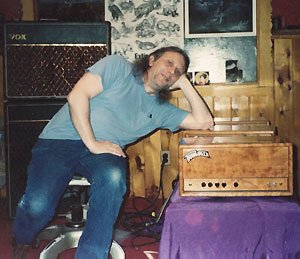“I want an amp to be fast and dynamic.
I want to hear the note with
multiple layers of harmonic complexity,
giving a fat, euphonic, and lyrical tone.
I like an amp to have an awesome clean sound,
yet rock my world when I dig in.”
“My goal is to make amps that make the soundtrack to people’s lives.”
 Trainwreck amps are hand-built with much of the building process performed on the very bench where Ken Fischer forged them. Ken’s family was more than fortunate to find a designer/builder who had long-time experience with Ken and influenced Ken during the prototyping stages of the amps’ designs; Someone who most importantly had ears that Ken truly trusted. Trainwreck amplifiers are currently constructed with the one goal of making amps that sound how Ken Fischer would have liked them to sound. A certain range of tone is all these amps are about so they could not possibly be manufactured in a factory. Every amp is still tweaked to compensate for the discrepancies in all of the amps different components. Thousands of weak sounding clones have proven that following the schematic circuit and layout of an amazing amp does not create an amazing amp. To quote JM, Trainwreck’s designer/builder, “Honestly, the key to building a good amplifier is to know what it should sound like before you start”. JM has successfully carried on the Trainwreck legacy to the point that more than half the ‘wrecks out there are built by him. The wait list for new amps keeps growing. JM’s half powered models are particularly popular.
Trainwreck amps are hand-built with much of the building process performed on the very bench where Ken Fischer forged them. Ken’s family was more than fortunate to find a designer/builder who had long-time experience with Ken and influenced Ken during the prototyping stages of the amps’ designs; Someone who most importantly had ears that Ken truly trusted. Trainwreck amplifiers are currently constructed with the one goal of making amps that sound how Ken Fischer would have liked them to sound. A certain range of tone is all these amps are about so they could not possibly be manufactured in a factory. Every amp is still tweaked to compensate for the discrepancies in all of the amps different components. Thousands of weak sounding clones have proven that following the schematic circuit and layout of an amazing amp does not create an amazing amp. To quote JM, Trainwreck’s designer/builder, “Honestly, the key to building a good amplifier is to know what it should sound like before you start”. JM has successfully carried on the Trainwreck legacy to the point that more than half the ‘wrecks out there are built by him. The wait list for new amps keeps growing. JM’s half powered models are particularly popular.
Ken Fischer’s relationship to tube guitar amplifiers has become legendary. Stories abound. He began building his own Trainwreck guitar amplifier heads in the early 1980’s. With one channel and no built in effects, the amps became renowned worldwide for their tone clean and dirty, and their response to touch. Generally he gave them women’s names instead of serial numbers. While he kept a log of notes on his amps (every amp was different, tweaked to meet his tonal preferences), he did not count them. They are somewhat rare and currently sell for somewhere in the $30,000 range. In Ken’s own words, written for his website:
TRAINWRECK was started in 1981 as amplifier repair and modification service in Colonia, New Jersey. By 1982 I had a request by an Atlantic recording artist to build him a custom amplifier. While I had built myself amps before, this was to become the start of building amps of my own design for other guitarists.
At that point I decided to come up with a blueprint of the goals for what an ultimate amp would be to suit my personal tastes. There were so many styles of amps already out there, I wanted to try to break through the limits of those designs. I knew that one channel was the way I’d go. When you had the typical two or three channel amp of the sixties, I found that the mixing circuits caused a compromise in the sound, response, and general feel of the amp. Also I noticed many amps were slow to respond to pick attack and lacked a proper response to changes in touch. I also found that master volume circuits did not give the response of power tubes. Master volumes are fine for some. There are styles of music that require them. I dislike spring reverb myself. For me it’s a cover-up for an amp that’s flat and dry sounding.
The good news is that many players, including several in the rock ‘n’ roll hall of fame, tell me my amps are among their favorites…
Photo taken by Dean Farley